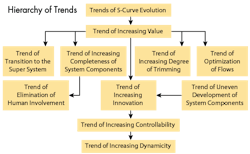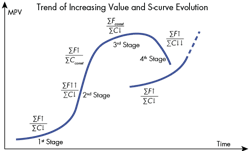In a recent column in this space, TRIZ Plus – A Modern Tool for Enhancing Design Innovation, I discussed a modern version of TRIZ some refer to as TRIZ Plus, an approach to innovation that involves much more than just solving problems. One of the key aspects of this process for systematically improving products and processes is identifying trends that suggest evolutionary winners. This brief column is intended to give you greater appreciation for the value of this specific aspect of TRIZ Plus. For simplification, let’s call this aspect Trends of Engineering System Evolution.
Proponents of TRIZ Plus describe these trends as a set of “empirically derived directions of engineering system development that describe the natural transitions of engineering systems from one state to another.” These trends were originally derived by analyzing thousands of patents. They have been confirmed by a careful review of the history of technology, and today these trends are argued to be true for all categories of engineering systems.
The figure below (Hierarchy of Trends) illustrates the hierarchical nature of these trends and the top level categories. For each of these, there are typically several sub-trends that describe slightly different directions. The bottom line, according to those who use it, is that the way your product is likely to evolve over time is predictable. If you understand these trends, you can anticipate what form the next generation of your product is likely to take. So, as the technology to realize this next generation becomes available (or you create it), you should be able to stay a step ahead of your competition.
As an example, one of the most important trends in product evolution is the “Trend of Increasing Value.” For this purpose, value is defined as being equal to (total functionality, F) / (total cost, C). The trend states that an engineering system evolves overtime so that its value always increases.
Think of this as an analogy to Darwinian evolution. Just as plants and animals continuously compete in their environments for territory, food, and reproductive success, your products are competing in the marketplace for sales, shelf space, and market share. Over time, you will win by bringing the best overall value to the market, in comparison to your competitors.
Defining value as F/C is important and suggests many different strategies for increasing value. Which approach you take should be tied to where your product lies on its S-curve of evolution. The figure below (Trends of Increasing Value and S-Curve Evolution) illustrates a variety of strategies. For example, an appropriate strategy for the early part of Stage 2 is to significantly increase overall functionality while allowing costs to increase at a slower rate. Conversely, an appropriate strategy for Stage 3 is to keep functionality constant while reducing product costs. When to switch from one strategy to another isn’t always clear, just as it is sometimes difficult to decide when you need to jump to a new S-curve. Knowing that these changes in product development and pricing strategy are virtually inevitable, however, should encourage you to be thinking about them regularly.
Nothing about product development is an exact science. Like many other engineering tools you use in your day-to-day work, the concept of Trends of Engineering System Evolution can give you better insights and point you in directions that may prove beneficial. It won’t reveal specifically what to do and it definitely won’t predict when something is going happen, but if you know the general evolutionary direction your product and the overall market are likely to follow, you will be more likely to choose winning ideas over ideas whose time has passed.
About the Author
Douglas Hoon
Founder and President
Douglas Hoon is a member of several small start-ups focused on sporting goods, advanced packaging concepts for portion-controlled foods and beverages, various consumer products, and safer guns. He previously spent almost 35 years in engineering fields related to precision optics and advanced composites manufacturing and innovation consulting. Hoon earned an M.S. in Mechanical Engineering from MIT and a B.S. in general engineering from the U.S. Military Academy. For more information, see his profile on LinkedIn.com.


